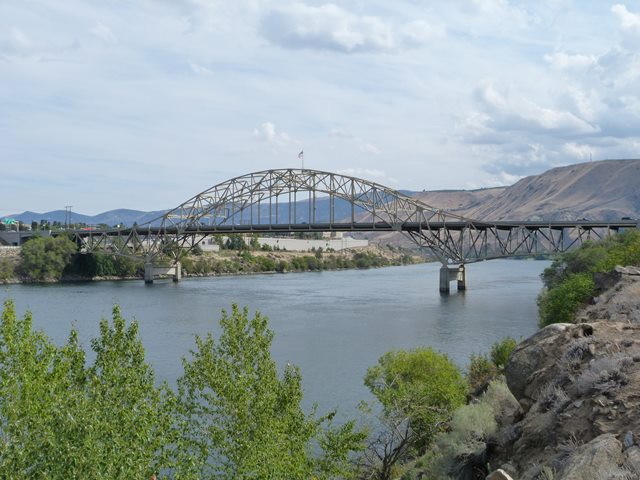We Recommend:
Bach Steel - Experts at historic truss bridge restoration.
BridgeHunter.com Phase 1 is released to the public! - Visit Now
George Sellar Bridge

Primary Photographer(s): Nathan Holth
Bridge Documented: August 21, 2014
WA-285 (5th Street, Stevens Street) Over Columbia River, Railroad, and WA-28 Ramp
Wenatchee and East Wenatchee: Chelan County, Washington and Douglas County, Washington: United States
Metal Cantilever Rivet-Connected Warren Truss, Fixed and Approach Spans: Concrete Curved T-Beam, Fixed
1950 By Builder/Contractor: American Bridge Company of New York, New York and Engineer/Design: Washington Department of Highways
Not Available or Not Applicable
480.0 Feet (146.3 Meters)
1,208.0 Feet (368.2 Meters)
60.7 Feet (18.5 Meters)
3 Main Span(s) and 2 Approach Span(s)
0003477A0000000

View Information About HSR Ratings
Bridge Documentation
View Archived National Bridge Inventory Report - Has Additional Details and Evaluation
View Historic Structure Reports For This Bridge

This is a very unusual bridge, yet at casual glance may appear to be one of a variety of more common bridge types that have this same general appearance. Looking closely at this bridge however, there are three pins on the truss above the main piers that are the main visual clue to the bridge's unusual design. In reality this bridge is a cantilever truss bridge, with deck truss anchor arms and half-through truss cantilever arms, but instead of having a truss span for the suspended span in the middle, a tied through arch span functions as the suspended span in the middle. The sketch above illustrates the parts of the bridge. During construction the suspended span functioned as a three hinge arch, but became a two hinge arch when completed.
Concrete curved t-beam approach spans at each end of the bridge, one at each end, were demolished and replaced in 2010. Around this time an additional eastbound lane was added. A number of alterations took place at this time. Most detrimental to the visual and historic integrity of the bridge was to cut the knee bracing out and flatten the portal and sway bracing. This alteration, likely intended to increase vertical clearance, has changed the visual appearance of the bridge. It no longer has the graceful curved bracing that was a standard feature of many mid-20th Century truss bridges in Washington State.
The Washington Department of Highways engineer who designed the bridge was R. W. Finke. The main contractor for the bridge was the General Construction Company of Seattle, Washington. The American Bridge Company of New York, New York was the steel superstructure contractor.
The bridge was awarded by the American Institute of Steel Construction as a prize bridge in Class One (span over 400 feet).
Be sure to view the Historic Structure Reports for this bridge available at the top of this narrative, as they contain more details about the history and design of this bridge.
This bridge was the replacement for the Wenatchee Cantilever Bridge.
![]()
Photo Galleries and Videos: George Sellar Bridge
Bridge Photo-Documentation
Original / Full Size PhotosA collection of overview and detail photos. This gallery offers photos in the highest available resolution and file size in a touch-friendly popup viewer.
Alternatively, Browse Without Using Viewer
![]()
Bridge Photo-Documentation
Mobile Optimized PhotosA collection of overview and detail photos. This gallery features data-friendly, fast-loading photos in a touch-friendly popup viewer.
Alternatively, Browse Without Using Viewer
![]()
Maps and Links: George Sellar Bridge
Coordinates (Latitude, Longitude):
Search For Additional Bridge Listings:
Bridgehunter.com: View listed bridges within 0.5 miles (0.8 kilometers) of this bridge.
Bridgehunter.com: View listed bridges within 10 miles (16 kilometers) of this bridge.
Additional Maps:
Google Streetview (If Available)
GeoHack (Additional Links and Coordinates)
Apple Maps (Via DuckDuckGo Search)
Apple Maps (Apple devices only)
Android: Open Location In Your Map or GPS App
Flickr Gallery (Find Nearby Photos)
Wikimedia Commons (Find Nearby Photos)
Directions Via Sygic For Android
Directions Via Sygic For iOS and Android Dolphin Browser
USGS National Map (United States Only)
Historical USGS Topo Maps (United States Only)
Historic Aerials (United States Only)
CalTopo Maps (United States Only)

